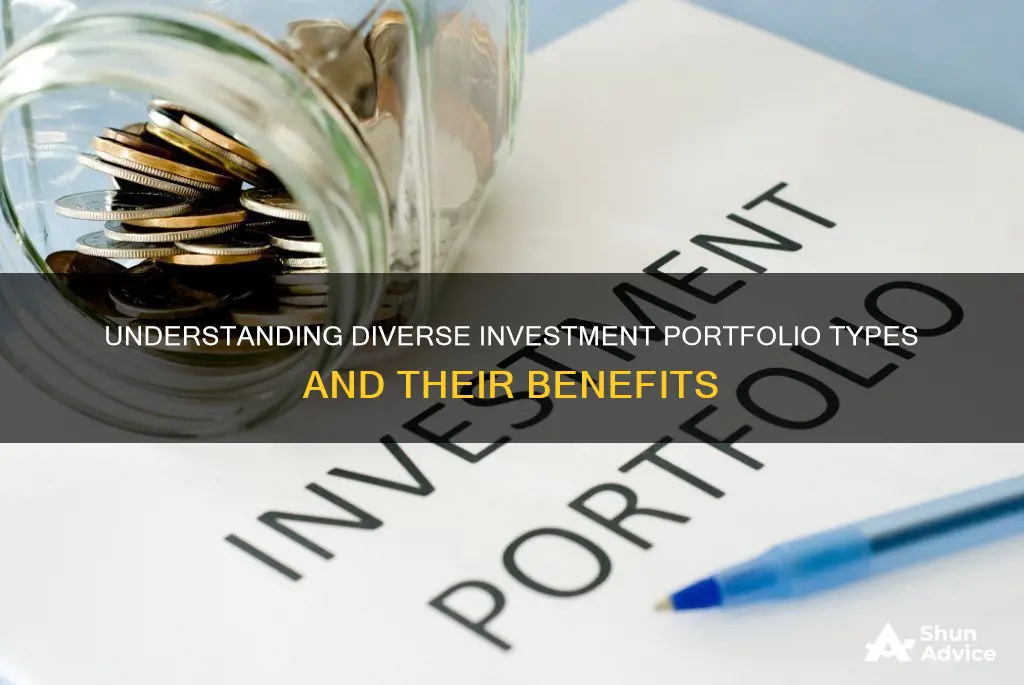
An investment portfolio is a collection of financial assets owned by an individual or institution. Portfolios can include a variety of different assets, such as stocks, bonds, cash, and real estate. The goal of an investment portfolio is to generate returns over time while managing risk. There are several types of investment portfolios, each with its own unique characteristics and risk-return profiles. The type of portfolio an individual chooses depends on their financial goals, risk tolerance, and investment horizon. Here are some of the most common types of investment portfolios:
| Characteristics | Values |
|---|---|
| Risk | High, Moderate, Low |
| Returns | High, Moderate, Low |
| Investor Profile | Young, Old, Risk-Averse, Aggressive, Conservative |
| Investment Types | Stocks, Bonds, Mutual Funds, Exchange-Traded Funds (ETFs), Real Estate, Cash, Cryptocurrency, Commodities, Art, Gold, etc. |
| Investment Strategy | Growth, Income, Value, Defensive, Blended, Hybrid, Speculative |
What You'll Learn

Aggressive portfolios
An aggressive investment portfolio is one that is more weighted towards stocks, with a higher-risk and higher-reward strategy. This type of portfolio is suitable for younger or more risk-tolerant investors who want to grow their assets quickly and are comfortable with the possibility of losses. Aggressive portfolios typically include volatile investments, such as growth stocks from companies that are growing very rapidly but may not be profitable yet.
Aggressive investors need to be mindful of risk management, keeping losses to a minimum and taking profits when they can. This strategy requires active management, as it is likely to be volatile and may need frequent adjustments depending on market conditions.
This strategy is often recommended for younger investors, as they have a longer investment horizon and losses early in their career have less impact. It is also a good strategy for those with a high tolerance for risk and a long-term investment outlook.
An aggressive portfolio might include small-cap growth stocks, or blue-chip stocks for a less risky approach.
Investing Aggressively at 75: Is It Too Late?
You may want to see also

Defensive portfolios
A defensive portfolio focuses on consumer staples that are resistant to economic downturns. These are stocks that provide consistent dividends and stable earnings regardless of the state of the overall stock market. They are shares in companies that produce or distribute consumer staples or goods that people need and tend to buy out of necessity, such as food, beverages, hygiene products, tobacco, and certain household items.
Defensive stocks are also known as non-cyclical stocks because they are not highly correlated with the business cycle. They tend to be more stable during the various phases of the business cycle and are less likely to face bankruptcy due to their relative strength during downturns.
A defensive investment strategy involves regular portfolio rebalancing to maintain the intended asset allocation. It also involves buying high-quality, short-maturity bonds and blue-chip stocks; diversifying across sectors and countries; placing stop-loss orders; and holding cash and cash equivalents in down markets.
Building a Diverse Investment Portfolio: Strategies for Success
You may want to see also

Income portfolios
An income portfolio is a type of investment portfolio that focuses on generating a steady stream of income for the investor. It is designed to provide reliable income through various assets, such as dividend-paying stocks, coupon-yielding bonds, and real estate investment trusts (REITs). The primary objective of an income portfolio is to deliver consistent cash flow, making it a popular choice for retirees or those seeking regular income.
In addition to stocks, income portfolios may also include bonds that pay regular interest to investors. These are known as coupon-yielding bonds, and they provide a steady stream of income in the form of interest payments. Bonds are typically considered less risky than stocks but usually generate lower returns.
Real estate investment trusts (REITs) are another important component of income portfolios. REITs are companies that invest in rental income-producing properties, and they are traded on stock exchanges. By investing in REITs, individuals can gain exposure to the real estate market without the hassle of directly owning and managing properties. REITs are required to distribute at least 90% of their taxable income to investors in the form of dividends, making them an attractive option for income-focused investors.
It is important to note that income portfolios are subject to market risks and economic conditions. For example, real estate investments, including REITs, can be sensitive to economic downturns, as construction and purchases may dry up during such periods. Therefore, it is crucial for investors to carefully assess their risk tolerance and diversify their income portfolios to mitigate potential losses.
Overall, an income portfolio is a powerful tool for individuals seeking reliable income during their retirement years or for any other financial goals. By investing in dividend-paying stocks, coupon-yielding bonds, and REITs, investors can generate a steady cash flow while also benefiting from the potential for capital appreciation.
Tilt Your Investment Portfolio: Value and Small-Cap Focus
You may want to see also

Speculative portfolios
Speculative investments include those with a high degree of volatility and a high probability of loss. Examples of speculative plays include initial public offerings (IPOs), stocks rumoured to be takeover targets, and companies in the process of developing a single breakthrough product. Speculative investments can also include peer-to-peer lending, derivative or hedging strategies, and high-yield bonds and bond funds.
It is important to note that speculative investments require a significant amount of research and active management. These stocks are typically traded frequently, rather than being held for the long term. Additionally, it is crucial to offset speculative investments with more stable, diversified holdings to mitigate the potential for significant losses.
Building a Tax-Efficient Investment Portfolio: Strategies for Success
You may want to see also

Hybrid portfolios
A hybrid portfolio is a diversified portfolio that includes a mix of two or more asset classes. It is a flexible investment strategy that allows investors to venture into different types of investments such as stocks, bonds, commodities, real estate, and even art.
Balanced funds, which hold a standard proportion of stocks and bonds (typically 60/40), are a common example of a hybrid fund. Blended funds, which mix growth and value stocks, are another type of hybrid fund. Target date or lifecycle funds, which start with an aggressive allocation and gradually shift to a more conservative approach over time, also fall into the hybrid category.
Maximizing Your HSA Savings: Is Investing Right For You?
You may want to see also







